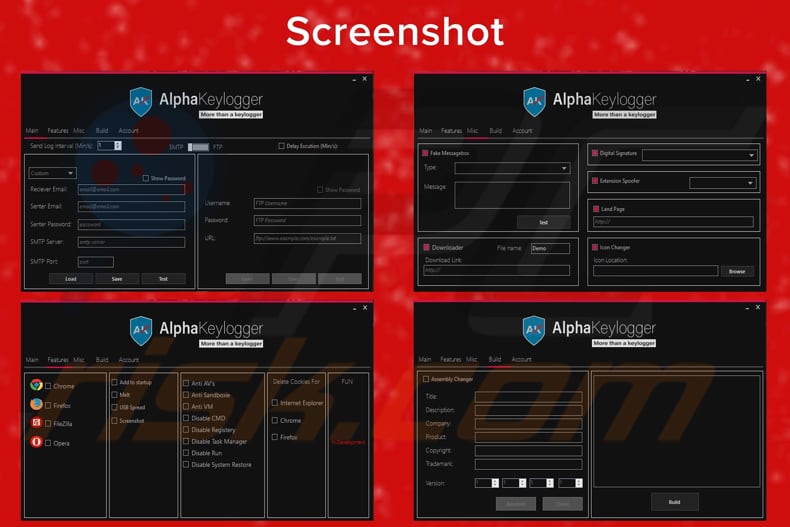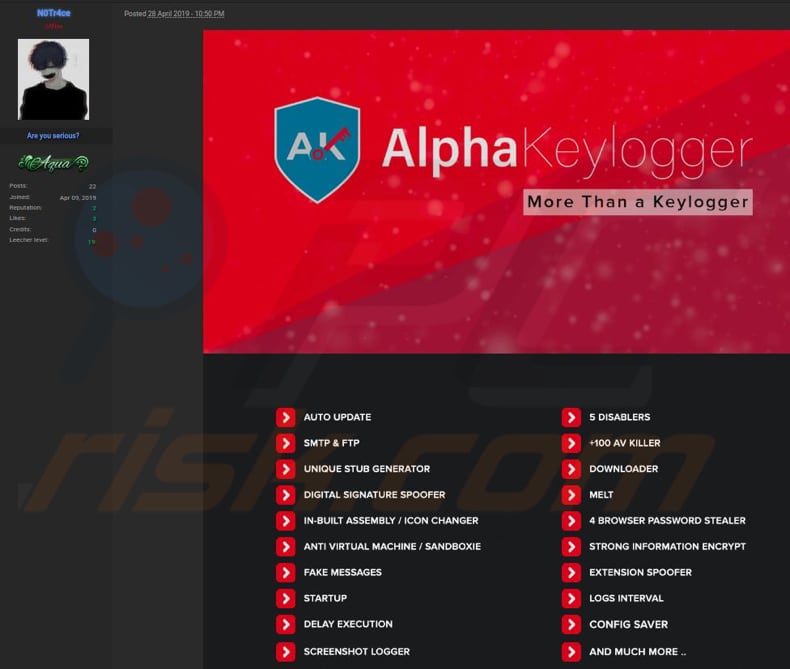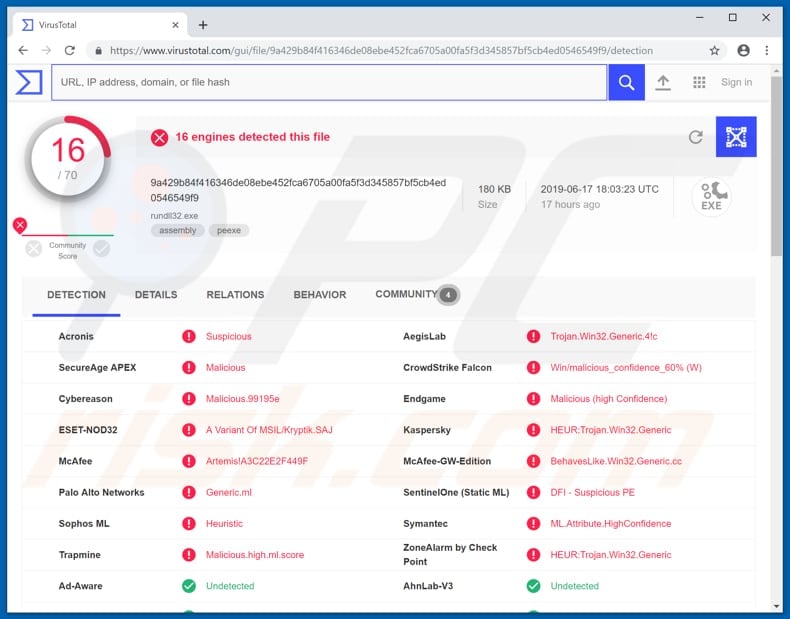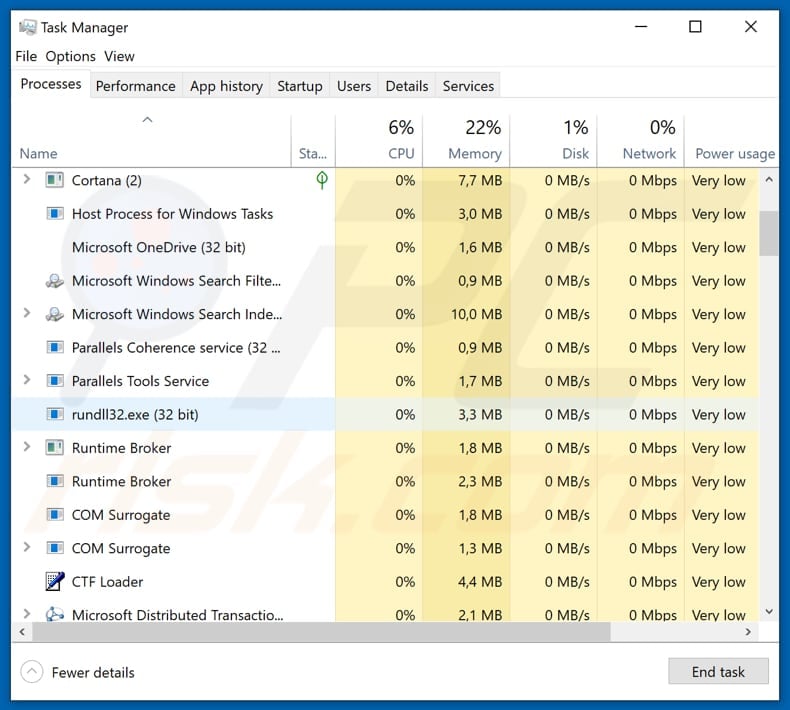Get free scan and check if your device is infected.
Remove it nowTo use full-featured product, you have to purchase a license for Combo Cleaner. Seven days free trial available. Combo Cleaner is owned and operated by RCS LT, the parent company of PCRisk.com.
What is Alpha KeyLogger?
Alpha KeyLogger is a keystroke logger, a tool that allows people (typically, cyber criminals) to record keys pressed by users via the keyboard and also mouse actions. This software is advertised on hacker forums and can be purchased by anyone.
Generally, cyber criminals try to trick unsuspecting people into installing this tool so that they can steal passwords and other confidential information.

Typically, programs such as Alpha KeyLogger are used to steal details such as passwords, logins of various accounts (including banking, cryptocurrency wallets, PayPal, etc.), information typed in emails, messaging apps and other personal data. Cyber criminals steal this information to generate revenue.
For example, to make online purchases, transactions, and so on. In most cases, people who have a keylogger installed experience problems relating to finances, online privacy, browsing safety, etc. Alpha KeyLogger is also capable of automatically updating itself.
Cyber criminals can use it to spoof digital signatures, take screenshots, disable installed antivirus suites and some other software, spoof file extensions, download other malicious software, encrypt information, and much more. If installed, Alpha KeyLogger runs in Task Manager as a process named "rundll32.exe" (it disguises itself as Dynamic Link Library).
If there is reason to believe that your computer is infected with Alpha KeyLogger, this program should be removed immediately. Most keystroke loggers that are used by cyber criminals can be detected with anti-virus or anti-spyware software. We strongly recommend that you run a full system scan to check for threats (installed malicious programs).
| Name | Alpha KeyLogger virus |
| Threat Type | Keystroke logger, Password stealing virus, Banking malware, Spyware |
| Detection Names | Avast (Win32:Malware-gen), BitDefender (Trojan.GenericKD.41378562), ESET-NOD32 (A Variant Of MSIL/Kryptik.SAJ), Kaspersky (HEUR:Trojan.Win32.Generic), Full List (VirusTotal) |
| Malicious Process Name(s) | rundll32.exe |
| Symptoms | Keystroke loggers are designed to stealthily infiltrate the victim's computer and remain silent, and thus no particular symptoms are clearly visible on an infected machine. |
| Distribution methods | Infected email attachments, malicious online advertisements, social engineering, software cracks. |
| Damage | Stolen banking information, logins, passwords, identity theft, privacy issues, installation of other malicious programs |
| Malware Removal (Windows) |
To eliminate possible malware infections, scan your computer with legitimate antivirus software. Our security researchers recommend using Combo Cleaner. Download Combo CleanerTo use full-featured product, you have to purchase a license for Combo Cleaner. 7 days free trial available. Combo Cleaner is owned and operated by RCS LT, the parent company of PCRisk.com. |
Alpha KeyLogger is similar to many other programs of this kind including, for example, HawkEye and Ardamax. Typically, these tools are used to extract personal details that can be used to generate revenue. These programs often run in the background and people who have them installed on their systems are unaware.
How did Alpha KeyLogger infiltrate my computer?
There are a number of ways used to trick people into installing keystroke loggers or other malicious programs (e,g,. ransomware). Emails are sent that include attached malicious files. These emails are usually presented as official and important, however, once the attached file is opened, it downloads and installs a malicious program.
Examples of files used by cyber criminals are Microsoft Office documents, PDF documents, JavaScript files, executables (.exe and others), archive files such as ZIP, RAR, and so on. Malware is also spread by uploading a malicious file to an untrustworthy site or software download channel and wait until someone downloads and opens it.
Some examples of dubious download sources are unofficial pages, Peer-to-Peer networks, third party downloaders, free file hosting or freeware download pages, and so on. Furthermore, people are often tricked into installing malicious software when they try to bypass software activation with 'cracking' tools.
These tools often download and install malware. Computers are also infected through unofficial software update tools. These download, install malicious programs rather than updating or fixing the program, or they exploit bugs/flaws of installed software.
Additionally, operating systems are often infected through trojans, however, these programs must already be installed - these programs then start proliferating and installing other malicious programs.
How to avoid installation of malware?
Download software from official and trustworthy websites and avoid using third party downloaders, installers and other such tools mentioned above. Do not open email attachments received from unknown or suspicious senders, especially if an email is irrelevant. Use implemented tools or functions to update installed software.
Do not trust other third party tools. Do not use 'cracking' tools to activate programs or operating systems, since this is illegal and they often install malware. Have reputable anti-spyware or anti-virus software installed and enabled.
If you believe that your computer is already infected, we recommend running a scan with Combo Cleaner Antivirus for Windows to automatically eliminate infiltrated malware.
Alpha KeyLogger advertised on hacker forum:

Another advertisement of Alpha KeyLogger:

The rundll32.exe file detected as a threat by virus detection engines:

Alpha KeyLogger process ("rundll32.exe") running in Task Manager:

Instant automatic malware removal:
Manual threat removal might be a lengthy and complicated process that requires advanced IT skills. Combo Cleaner is a professional automatic malware removal tool that is recommended to get rid of malware. Download it by clicking the button below:
DOWNLOAD Combo CleanerBy downloading any software listed on this website you agree to our Privacy Policy and Terms of Use. To use full-featured product, you have to purchase a license for Combo Cleaner. 7 days free trial available. Combo Cleaner is owned and operated by RCS LT, the parent company of PCRisk.com.
Quick menu:
- What is Alpha KeyLogger?
- STEP 1. Manual removal of Alpha KeyLogger malware.
- STEP 2. Check if your computer is clean.
How to remove malware manually?
Manual malware removal is a complicated task - usually it is best to allow antivirus or anti-malware programs to do this automatically. To remove this malware we recommend using Combo Cleaner Antivirus for Windows.
If you wish to remove malware manually, the first step is to identify the name of the malware that you are trying to remove. Here is an example of a suspicious program running on a user's computer:

If you checked the list of programs running on your computer, for example, using task manager, and identified a program that looks suspicious, you should continue with these steps:
 Download a program called Autoruns. This program shows auto-start applications, Registry, and file system locations:
Download a program called Autoruns. This program shows auto-start applications, Registry, and file system locations:

 Restart your computer into Safe Mode:
Restart your computer into Safe Mode:
Windows XP and Windows 7 users: Start your computer in Safe Mode. Click Start, click Shut Down, click Restart, click OK. During your computer start process, press the F8 key on your keyboard multiple times until you see the Windows Advanced Option menu, and then select Safe Mode with Networking from the list.

Video showing how to start Windows 7 in "Safe Mode with Networking":
Windows 8 users: Start Windows 8 is Safe Mode with Networking - Go to Windows 8 Start Screen, type Advanced, in the search results select Settings. Click Advanced startup options, in the opened "General PC Settings" window, select Advanced startup.
Click the "Restart now" button. Your computer will now restart into the "Advanced Startup options menu". Click the "Troubleshoot" button, and then click the "Advanced options" button. In the advanced option screen, click "Startup settings".
Click the "Restart" button. Your PC will restart into the Startup Settings screen. Press F5 to boot in Safe Mode with Networking.

Video showing how to start Windows 8 in "Safe Mode with Networking":
Windows 10 users: Click the Windows logo and select the Power icon. In the opened menu click "Restart" while holding "Shift" button on your keyboard. In the "choose an option" window click on the "Troubleshoot", next select "Advanced options".
In the advanced options menu select "Startup Settings" and click on the "Restart" button. In the following window you should click the "F5" button on your keyboard. This will restart your operating system in safe mode with networking.

Video showing how to start Windows 10 in "Safe Mode with Networking":
 Extract the downloaded archive and run the Autoruns.exe file.
Extract the downloaded archive and run the Autoruns.exe file.

 In the Autoruns application, click "Options" at the top and uncheck "Hide Empty Locations" and "Hide Windows Entries" options. After this procedure, click the "Refresh" icon.
In the Autoruns application, click "Options" at the top and uncheck "Hide Empty Locations" and "Hide Windows Entries" options. After this procedure, click the "Refresh" icon.

 Check the list provided by the Autoruns application and locate the malware file that you want to eliminate.
Check the list provided by the Autoruns application and locate the malware file that you want to eliminate.
You should write down its full path and name. Note that some malware hides process names under legitimate Windows process names. At this stage, it is very important to avoid removing system files. After you locate the suspicious program you wish to remove, right click your mouse over its name and choose "Delete".

After removing the malware through the Autoruns application (this ensures that the malware will not run automatically on the next system startup), you should search for the malware name on your computer. Be sure to enable hidden files and folders before proceeding. If you find the filename of the malware, be sure to remove it.

Reboot your computer in normal mode. Following these steps should remove any malware from your computer. Note that manual threat removal requires advanced computer skills. If you do not have these skills, leave malware removal to antivirus and anti-malware programs.
These steps might not work with advanced malware infections. As always it is best to prevent infection than try to remove malware later. To keep your computer safe, install the latest operating system updates and use antivirus software. To be sure your computer is free of malware infections, we recommend scanning it with Combo Cleaner Antivirus for Windows.
Share:

Tomas Meskauskas
Expert security researcher, professional malware analyst
I am passionate about computer security and technology. I have an experience of over 10 years working in various companies related to computer technical issue solving and Internet security. I have been working as an author and editor for pcrisk.com since 2010. Follow me on Twitter and LinkedIn to stay informed about the latest online security threats.
PCrisk security portal is brought by a company RCS LT.
Joined forces of security researchers help educate computer users about the latest online security threats. More information about the company RCS LT.
Our malware removal guides are free. However, if you want to support us you can send us a donation.
DonatePCrisk security portal is brought by a company RCS LT.
Joined forces of security researchers help educate computer users about the latest online security threats. More information about the company RCS LT.
Our malware removal guides are free. However, if you want to support us you can send us a donation.
Donate
▼ Show Discussion